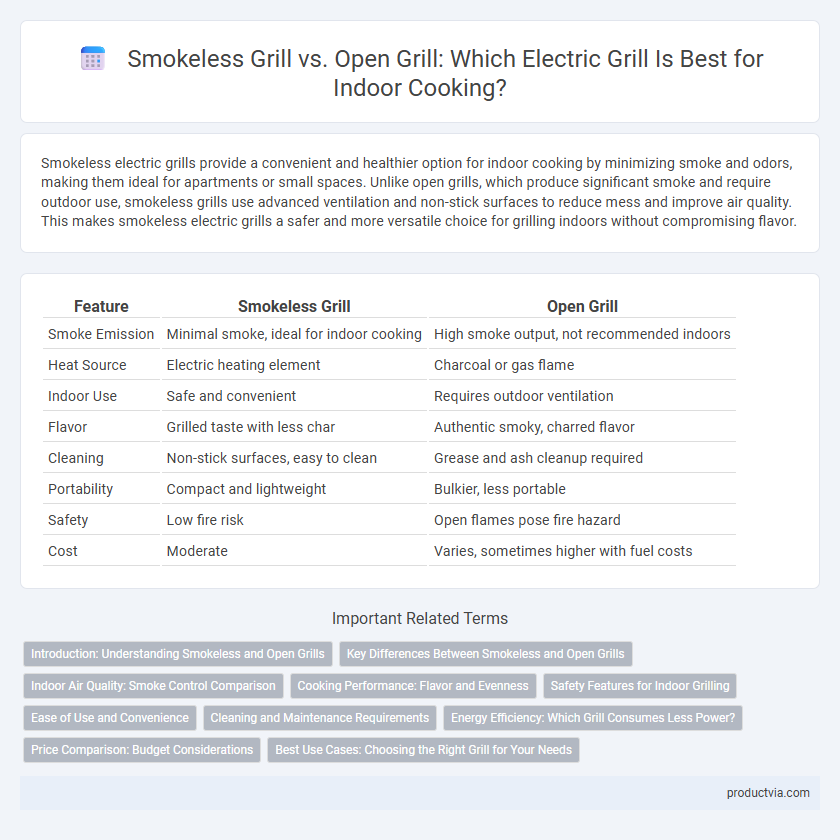Smokeless electric grills provide a convenient and healthier option for indoor cooking by minimizing smoke and odors, making them ideal for apartments or small spaces. Unlike open grills, which produce significant smoke and require outdoor use, smokeless grills use advanced ventilation and non-stick surfaces to reduce mess and improve air quality. This makes smokeless electric grills a safer and more versatile choice for grilling indoors without compromising flavor.
Table of Comparison
| Feature | Smokeless Grill | Open Grill |
|---|---|---|
| Smoke Emission | Minimal smoke, ideal for indoor cooking | High smoke output, not recommended indoors |
| Heat Source | Electric heating element | Charcoal or gas flame |
| Indoor Use | Safe and convenient | Requires outdoor ventilation |
| Flavor | Grilled taste with less char | Authentic smoky, charred flavor |
| Cleaning | Non-stick surfaces, easy to clean | Grease and ash cleanup required |
| Portability | Compact and lightweight | Bulkier, less portable |
| Safety | Low fire risk | Open flames pose fire hazard |
| Cost | Moderate | Varies, sometimes higher with fuel costs |
Introduction: Understanding Smokeless and Open Grills
Smokeless electric grills use advanced heating elements and non-stick surfaces to minimize smoke production, making them ideal for indoor cooking in apartments or homes without extensive ventilation. Open grills, typically fueled by charcoal or gas, generate significant smoke and require outdoor use or well-ventilated spaces to avoid indoor air quality issues. Choosing a smokeless grill enhances indoor air safety and convenience while delivering similar grilling flavors without the smoke and odors associated with open grills.
Key Differences Between Smokeless and Open Grills
Smokeless grills use advanced heating elements and non-stick surfaces to minimize smoke production, making them ideal for indoor cooking without triggering alarms or odors. Open grills rely on direct flame and charcoal or gas, producing significant smoke and requiring outdoor use or well-ventilated areas. Key differences include smoke output, heat control precision, and suitability for indoor environments, with smokeless grills offering safer, cleaner cooking experiences.
Indoor Air Quality: Smoke Control Comparison
Smokeless electric grills significantly improve indoor air quality by reducing smoke emissions compared to open grills, which produce substantial smoke and airborne particulates. Advanced filtration and ventilation systems in smokeless grills minimize indoor pollutants, making them more suitable for confined spaces. This smoke control results in fewer respiratory irritants and less odor, promoting a healthier indoor cooking environment.
Cooking Performance: Flavor and Evenness
Smokeless electric grills provide consistent heat distribution, ensuring even cooking without flare-ups that can char food unevenly. Unlike open grills, electric models retain moisture and enhance natural flavors by reducing smoke exposure, resulting in a cleaner taste. Their advanced heating elements maintain steady temperatures, delivering perfectly grilled results ideal for indoor cooking environments.
Safety Features for Indoor Grilling
Smokeless grills are equipped with advanced ventilation systems and drip trays that reduce smoke emissions, making them safer for indoor cooking by minimizing fire hazards and improving air quality. In contrast, open grills produce significant smoke and require constant supervision to prevent flare-ups and carbon monoxide buildup, posing higher safety risks in enclosed spaces. Choosing a smokeless grill enhances indoor safety through controlled heat distribution and integrated smoke filtration, ensuring a safer cooking environment.
Ease of Use and Convenience
Smokeless electric grills offer superior ease of use with adjustable temperature controls and non-stick surfaces that simplify cleaning, making them ideal for indoor cooking. They eliminate smoke and reduce odors, allowing safe and convenient use in confined spaces without the need for ventilation. In contrast, open grills require more maintenance and produce smoke, limiting their practicality and comfort indoors.
Cleaning and Maintenance Requirements
Smokeless electric grills feature non-stick surfaces and detachable components designed for easy cleaning and minimal maintenance, making them ideal for indoor use. Open grills often accumulate grease and food residue in hard-to-reach areas, requiring more intensive scrubbing and upkeep. The smokeless grill's design reduces residue buildup, significantly simplifying routine cleaning and extending its lifespan in indoor cooking environments.
Energy Efficiency: Which Grill Consumes Less Power?
Smokeless electric grills consume significantly less power compared to open grills, typically using between 1,200 to 1,800 watts, whereas open grills can demand up to 3,000 watts due to high heat output and prolonged preheating times. The efficient heating elements in smokeless grills provide rapid and consistent temperature control, minimizing energy waste during indoor cooking sessions. Energy consumption studies reveal that electric smokeless grills reduce electricity usage by approximately 30-40% compared to traditional open grilling methods.
Price Comparison: Budget Considerations
Smokeless grills typically have a higher upfront cost than open grills due to advanced ventilation technology and non-stick surfaces designed for indoor use. Open grills are generally more affordable but may require additional expenses like ventilation systems or smoke detectors to manage indoor smoke. Cost efficiency depends on long-term use and maintenance, with smokeless grills offering savings by reducing smoke-related damages and cleanup.
Best Use Cases: Choosing the Right Grill for Your Needs
Smokeless grills offer a controlled cooking environment ideal for indoor use, minimizing smoke and odor, making them perfect for apartments or small kitchens. Open grills provide higher heat and char flavor, better suited for outdoor settings where smoke ventilation is not a concern. Selecting the right grill depends on your cooking space, desired flavor intensity, and ventilation capabilities to ensure optimal indoor grilling experiences.
Smokeless grill vs open grill for indoor cooking Infographic

 productvia.com
productvia.com